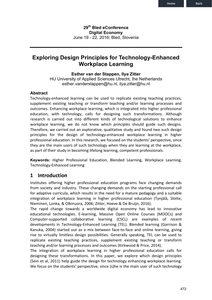From the article: "Abstract, technology-enhanced learning can be used to replicate existing teaching practices, supplement existing teaching or transform teaching and/or learning process and outcomes. Enhancing workplace learning, which is integrated into higher professional education, with technology, calls for designing such transformations. Although research is carried out into different kinds of technological solutions to enhance workplace learning, we do not know which principles should guide such designs. Therefore, we carried out an explorative, qualitative study and found two such design principles for the design of technology-enhanced workplace learning in higher professional education. In this research, we focused on the students' perspective, since they are the main users of such technology when they are learning at the workplace, as part of their study in becoming lifelong learning, competent professionals."
DOCUMENT

From the article: "The goal of higher professional education is to enable students to develop into reflective practitioners, having both a firm theoretical knowledge base as well as appropriate, professional attitudes and skills. Learning at the workplace is crucial in professional education, because it allows students to learn to act competently in complex contexts and unpredictable situations. Reflection on learning during an internship is hard to interweave with the working process, which may easily result in students having little control over their own learning process while at work. In this study, we aim to discover in what way we can effectively use technology to enhance workplace learning, by synthesizing design propositions for Technology- Enhanced Workplace Learning (TEWL). We conducted design-based research which is cyclic in nature. Based on preliminary research, we constructed initial design propositions and developed a web-based app (software program for mobile devices) providing interventions based on these propositions. In a pilot study, students from different educational domains used this app to support their workplace learning. We evaluated the initial design propositions by carrying out both a theoretical and a practical evaluation. With the insights obtained from these evaluations, we developed a next version of the design propositions and improved the app accordingly. The research result is a set of design propositions for TEWL. For daily practice, the developed web-based app is available for re-use and further research and development."
DOCUMENT

The in-depth assessment of the situation of the European textile and clothing sector is composed by six independent reports with a close focus on key aspects useful to understand the dynamics and the development of the textile and clothing industry, drivers of change – most notably the impact of the financial crisis – and identification of policy responses and best practices. This has been done in six specific tasks leading to the six reports: Task 1 Survey on the situation of the EU textile and clothing sector Task 2 Report on research and development Task 3 Report on SME situation Task 4 Report on restructuring Task 5 Report on training and Education Task 6 Report on innovation practices The aim of Task 2 was to analyse in detail how specialised research an innovation centres liaise with textile/clothing enterprises and analyse the process of transforming textile/clothing research innovations into new products/processes available in the market.
MULTIFILE
